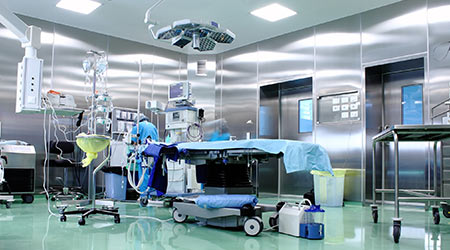
Contributed by Xenex Disinfection Services.
Surgical Site Infections (SSIs) devastate patients and can cost a healthcare facility more than $50,000 in additional patient care per infection. Surfaces in the operating room (OR) may harbor superbugs and other pathogens that contribute to the infection risk.
Studies have shown that contamination builds in the OR during the day, even when it is manually cleaned between procedures. Some of the superbugs that threaten patients and can cause SSIs, such as Staphylococcus aureus, Enterococcus, Klebsiella and Pseudomonas, are capable of living on OR surfaces from 1.5 hours to more than 30 months.
Pulsed xenon ultraviolet (PX-UV) light has been proven to quickly destroy the germs and bacteria in ORs that can cause infections. As a result, hundreds of hospitals use this equipment to disinfect their ORs after the day’s procedures are complete. Two hospitals have published peer-reviewed studies showing 46- to 100-percent reductions in their SSI rates when the equipment was used to disinfect ORs after terminal cleaning.
In an attempt to reduce contamination in the OR between surgeries, researchers evaluated using PX-UV light in the OR and found that it can effectively disinfect high touch surfaces in just 2 minutes.
According to the new study “Evaluation of a pulsed xenon ultraviolet disinfection system to decrease bacterial contamination in operating rooms” Haddad et al.; published in BMC Infectious Diseases, “this short cycle time may make between-case cleaning [with PX-UV] in the OR a viable option and something hospitals should consider operationalizing within their protocol.”
The study found that a 2-minute cycle of intense pulsed xenon ultraviolet (PX-UV) light disinfection eliminated 72% more pathogens on high-touch surface areas in the OR than manual cleaning alone. The authors noted that the short room turnover time is feasible, even for a busy OR, and could potentially reduce pathogen transmission to patients and reduce SSI rates.
The Xenex LightStrike Germ-Zapping Robot has been credited by numerous health care facilities across the U.S. for helping them reduce their infection rates significantly. Several hospitals have published their 46- to 100-percent Clostridium difficile (C.diff), MRSA and/or Surgical Site infection rate reduction studies in peer-reviewed journals. Twenty-three peer-reviewed articles have been published about the LightStrike robot’s effectiveness, including nine crediting the intense pulsed xenon UV technology for contributing to a facility’s reduction in HAI rates. To date, the only SSI reduction data credited to UV disinfection and published in a peer-reviewed journal is from hospitals using Xenex pulsed xenon (non-mercury bulb) UV technology.
More than 400 hospitals, Veterans Affairs and Department of Defense facilities in the U.S., Canada, Africa, UK, Japan and Europe use Xenex robots, which are also in use in skilled nursing facilities, ambulatory surgery centers and long term acute care facilities.

 Celebrating BSCAI's 60th Anniversary eBook
Celebrating BSCAI's 60th Anniversary eBook The Down and Dirty on Cleaning in Virus Season
The Down and Dirty on Cleaning in Virus Season How Surfactant Use is Expanding in Commercial Cleaning
How Surfactant Use is Expanding in Commercial Cleaning